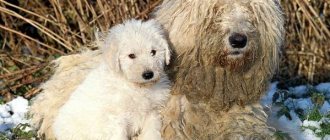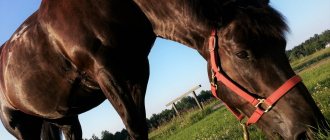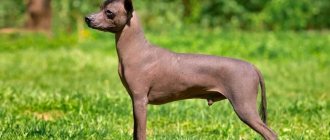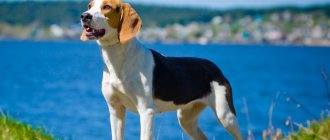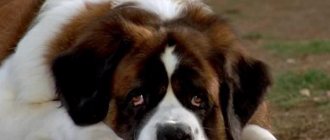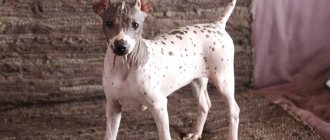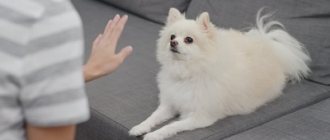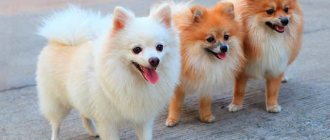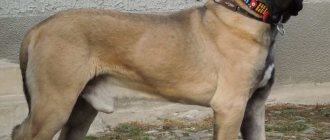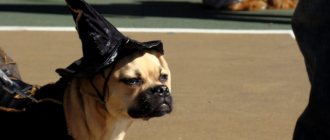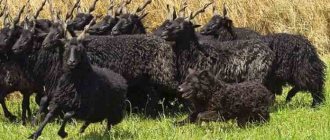Home » Dog Breeds
Classification Origin: Hungary
Class: according to the IFF, group – 1, section – 1, number – 53.
Color: only white, black dogs are also bred, but this color does not meet the breed standard
Dimensions: height for males is at least 70 cm, for females - at least 65 cm, males weigh from 50 to 60 kg, females - from 40 to 50 kg
Lifespan: 10-12 years
The Komondor is a dog adapted to work as a shepherd and guard. Luxurious wool allows it to camouflage perfectly in a sheep flock.
Looking at the photo, we can assume that this animal is quite large and has a lot of weight. But in fact, it is about half the weight of many other breeds of its size, such as the Hovawart, German Boxer and Tosa Inu .
Under the long rope dreadlocks you will not see any eyes, no paws, no tail - only the black button of the nose stands out against the background of the white fur.
This dog, in the absence of a potential threat, is calm and balanced, but when danger approaches, it becomes aggressive and will not hesitate to attack the enemy.
The Komondor does not attack like a fighting dog , he delivers powerful blows with his head, which completely demoralizes the enemy - this is how he breaks the back of a wolf who attacked the flock of sheep entrusted to him.
The fury and swiftness with which the Komondor attacks can only be slightly mitigated by the complete absence of resistance.
- 2 Psychology
- 3 Application
- 4 How to choose a dog
- 5 Features of care
- 6 Combing
- 7 Walking
- 8 Food
- 9 Health
- 10 Characteristic diseases
- 11 Vaccinations
- 12 Mating
History of the breed
As a result of research, scientists have come to the conclusion that the ancestors of the Komondor are ancient shepherd dogs crossed with wolves (by the way, the modern hybrid of a wolf and a shepherd dog is called a wolfdog ). Also, some notice a certain similarity between the Komondor and the South Russian Shepherd Dog .
But the Hungarians have another version, or rather a legend, that this dog came from the unnatural “marriage” of a sheep and a wolf.
The Komondors came to the territory of Hungary from the coastal regions of the Black Sea, where they lived together with the Magyar tribes. There they were used as guards and helped herd flocks.
But the Golden Horde forced the tribes out of their inhabited territory, and loyal dogs followed them. About ten centuries have passed since then, but these shepherd dogs still live in Hungary.
Due to the fact that the Komondor was prohibited from crossing with other dog breeds, he completely retained his original appearance and character traits.
Interesting! A king among shepherds - this is how the medieval author Amos Comenius dubbed this dog. This “talking” nickname was liked by many connoisseurs of this amazing breed and they remember it even today. Often they simply say “king”, forgetting that “among the shepherds”!
The origin of the breed's name is also controversial. Some, starting from the nickname given by the ancient author, argue that the name Komondor is not accidental, since translated from Italian “cane commodore” it means “king of dogs”.
Others believe that the Magyars themselves named these animals and the name in no way depends on the medieval nickname.
Komondor: a dog with dreadlocks
At first glance, it is difficult to determine who is in front of you. The unusual appearance of this dog attracts attention. The Hungarian Shepherd, or Komondor (from the Hungarian "Komondor", often called "Commander"), is the king of the shepherd dogs. This breed is distinguished by its impressive size, sonorous bark, majestic posture and amazing calmness.
At first glance, the Komondor may be intimidating, but his inquisitive gaze will soon change this first impression. The Komondor is a guard dog. Protects people, homes, sheep. The Komondor was first mentioned in a 1544 book, The History of King Astyagis by Peter Caconius. In a 1653 text, Amos Comenius mentions Komondors as guarding herd dogs. In 1778, Michael Klein wrote about meeting Komondors in the vicinity of the Hungarian Raba River, where they were used to fight wolves.
The Komondor is ideal as a guard dog: he is fearless, brave, loyal, always vigilant. His obvious intelligence makes him easy to train, although even as a puppy, he will try to outwit his masters and establish his own rules. However, after the desired relationship with the family where he lives is established, he will happily adhere to the existing routine in the house.
The Komondor is a beautiful, muscular dog with impressive strength. Long, thick hair covers the entire body of the Komondor. The Komondor's coat is made up of hard guard hairs and a wavy, soft undercoat. The combination of these two types of pile forms cords. The Komondor's coat is also amazing because it grows throughout the dog's life, reaching a length of 70 cm, and after swimming or rain it has virtually no odor.
Psychology
The behavior and character of an adult Komondor dog largely depends on timely and correct socialization. The puppy should be taught from an early age to communicate with other dogs and people, and also be adapted to different situations.
If these requirements are neglected, then aggression will prevail in the pet’s character.
An animal that develops in a kind, caring atmosphere will become an excellent pet - loving and devoted
- The Komondor matures late - at about three years of age. Looking at the photo, it is impossible to even imagine that such a large dog is capable of acting like a puppy. Every potential owner should know this feature so that the character of a seemingly adult pet does not raise any questions.
- If there is no threat, then representatives of this breed behave calmly. They are completely indifferent to strangers and other people's children. But at the same time they show friendliness towards their owner’s friends.
- The Komondor is always fiercely loyal to its owner and all members of his family. It is very difficult for him to tolerate a change of owner; for this dog such a situation is fraught with stress. And if you choose him as your pet, then remember - this is forever!
- The Hungarian Shepherd is independent and intelligent, but at the same time cunning and stubborn. As a small puppy, she may exhibit leadership tendencies and will try to dominate her owner. Early training - at the age of 4-6 months - will help smooth out the “sharp corners” of character.
Interesting! Komondor males are stubborn, so you should be very careful when choosing a trainer. Bitches, on the contrary, are more affectionate and much easier to train!
- The Komondor learns information quickly, but training must be varied, otherwise the dog will get bored and refuse to follow commands in the future. Training, which always contains a lot of new information, will bring positive results.
Only a positive teaching style is allowed, which will be reinforced with constant praise and treats. Aggressive behavior in the process of education will lead to the formation of negative character traits of the pet
- This dog will become a real “stone wall” for your children. There are no circumstances under which she could harm the babies. The Komondor will happily share games with children, wake them up in the morning and lick them devotedly.
- The guard shepherd dog selflessly guards the house every night, but during the day it takes a long nap. You can only hear a Komondor's bark in exceptional cases; he even attacks silently. This dog's voice is deep and very loud.
Breed Commander (Komondor): Hungarian guard shepherd dog
A huge white dog, covered with long hair, as if curled into dreadlocks. The eyes are not visible, only the black button of the nose.
Breed standard
Color
. only white. Some breeders breed black dogs, but this color does not meet breed standards.
Wool
thick, long, braided into “ribbons”. The coat grows throughout the dog's life. It is finally formed after 2 years of age.
The nose should be black. Dark gray and dark brown are allowed. Other colors are a disqualifying fault.
The breed standard does not allow any variations.
The lifespan of a dog is about 12 years.
There are usually 3 puppies in a litter.
Appearance
Features and character of the Komondor
If you are just planning to get a dog of this breed, you should think about the following features.
This large, powerful dog is better off living in a local area
. She needs a lot of physical activity and space. If you are going to keep a dog in a city apartment, then you will need to devote a lot of time and physical effort to walking it (1-2 hours twice a day - minimum).
Requires careful care. Because the coat is white, the dog needs to be washed frequently
. You cannot comb the fur with a comb, you only need to “disassemble” it with your hands. The shedding of this breed is insignificant, but due to the thickness and length of the coat, it seems that a lot of it falls out. There is no characteristic “dog” smell.
On a walk
Komondor dogs become adults quite late, at the age of 3 years. Accordingly, until this age the dog behaves like a puppy. You just need to know this so that the behavioral characteristics of a seemingly adult pet do not cause confusion.
The character of some dogs is dominated by independence, others are more affectionate. The breeder knows the character of each puppy and will advise you on the type that will suit you best.
Komondor or dog with dreadlocks
Either a sheep or a dog. The eyes are tightly covered with wool, like curtains. Because of this, it is impossible to understand whether this miracle of nature is planning to attack, retreat, or simply ignore you. Only the owner of the Komondor
can read the thoughts of his pet, and it’s not a fact that he will read it correctly.
Although, in fairness, it should be noted that the thoughts of a Komondor are always crystal clear, honest and straightforward. In a nutshell, this dog has one goal: “To serve and protect.”
How to get lost in a flock of sheep
If you believe the Hungarian legends, namely Hungary is officially considered the birthplace of these amazing dogs, then the Komondor originated as a result of unnatural mating games between sheep and wolves. Of course, it’s hard to imagine a wolf who, instead of just tearing a sheep’s throat out, begins, sorry, to look after it or whatever happens in such cases.
And if there was even a word of truth in these legends, then the consequences could be the most terrible. Just imagine a sheep commanding a pack of wolves, or a wolf, due to heredity, knowing perfectly well the habits of sheep and, of course, shamelessly using this for his own selfish purposes.
But we sincerely believe that “nothing happened” between the wolf and the sheep. And no matter where the Komondor came from, this dog turned out to be simply amazing: brave, strong, independent, knowing its charges well. A dog that, thanks to its appearance, can easily get lost in a flock of sheep if, for example, you need to confuse, deceive or punish the same greedy wolf.
By the way, legends are legends, but experts officially state that the origin of this dog was not without wolf genes. One of the most important working qualities of Komondors is that all responsibility for protecting the flock can be transferred to them for a long time, and these dogs will fully justify the trust placed in them.
Komondor or Hungarian Shepherd
- a very unusual breed of dog. At first glance, it is sometimes difficult to recognize a dog in a huge ball of hair hanging down in dreadlocks, like a Jamaican Rastafarian. But despite their slightly awkward appearance, Komondors are excellent protectors, non-aggressive towards their owners, but always ready to help if the owner is in danger.
Komondor is a very ancient breed,
whose history goes back more than 1000 years. This breed was developed by the Magyars (Hungarians) in the 9th century, hence the second name of the Komondor - the Hungarian Shepherd Dog. Comodoros were used for herding livestock, most often sheep. A large, strong dog was able to protect the herd from foxes, wolves, and, if necessary, even from bears. The long hair of the Hungarian Shepherd, matted into peculiar dreadlocks, protected it from the harsh climate: the Komondor does not tolerate wind, rain and snow, as well as low temperatures. Such a coat served not only as reliable protection from wounds and bites of predators, but also as excellent camouflage: try to spot a large white shaggy dog in a herd of white shaggy sheep.
The Hungarian Shepherd is a large breed of dog.
Males of the Komondor breed have an average height at the withers of 70-80 cm and weigh 50-60 kg, and females reach a height of 66-70 cm at the withers and weigh 35-50 kg. The Hungarian Shepherd has a strong build, a massive, strong skeleton and well-developed muscle mass. According to the breed standard, Komondors have drooping ears, dark and almond-shaped eyes, a black nose, and bangs that fall over the eyes.
But the most characteristic distinguishing feature by which a Hungarian Shepherd can be recognized is its coat.
The length of the Komondor's coat can reach 60 cm. Komondor puppies are covered with delicate fluff, but by the age of two years the puppy fluff falls out and coarse hair begins to grow, which is gradually woven into strands (cords, dreadlocks). Two types of hair coat are involved in the formation of dreadlocks: a soft undercoat, consisting of fine hair, and a thick, coarse outer coat. Dreadlocks grow throughout the Komondor's life, becoming thicker and longer. The Hungarian Shepherd does not shed: even if the hair falls out of the hair follicle, it will forever remain woven into the plait.
As already mentioned, such a specific coat protected the Komondor from bad weather and animal bites.
By the way, dreadlocks protect the dog from both cold and heat.
This is a kind of warm cotton robes worn by desert dwellers: they do not heat the body, but only maintain its natural temperature. Even if the temperature outside is over 40 degrees, thanks to dreadlocks, the temperature at the surface of the dog’s body will remain unchanged. According to the standard, the Komondor's coat can only be white!
By the way, the Hungarian Shepherd does not have a specific “dog” smell.
This is due to the origin of the breed. Since Komondors were herding dogs that guarded herds, the dog's scent could alert predators. The lack of smell helped catch predators by surprise. Therefore, the commander smells like the environment around him.
Komondors are very intelligent dogs with a balanced character.
They not only blindly obey their owner, following commands, but are also capable of making independent decisions, analyzing a particular situation. Hungarian Shepherds are brave, reliable, hardworking dogs that clearly understand their responsibilities and always carry them out to the end. Komondors are usually loyal to their owner and his family, obeying them in everything. However, you will have to earn the Komondor's loyalty and obedience.
The Hungarian Shepherd is an excellent protector of your home and children.
They are usually wary and even suspicious of strangers, but if there is no obvious danger and open aggression, the Komondor will never attack first. They will protect children and pets. However, keep in mind that males have a harsher temperament than females. Therefore, male dogs are more suitable for guarding a house or cottage, but to protect children and household members it is better to take a female dog.
If you got a Hungarian Shepherd to guard your territory, you should not put it on a chain:
The Komondor is accustomed to freedom of action. Considering that such a dog can easily decide for itself what to do, you can safely leave it free, without a leash. Komondors rarely bite uninvited guests. They are used to headbutting. The Hungarian Shepherd has such a strong neck and powerful head that with one blow they can easily break the spine of a wolf. In this case, a person will get away with a fracture of, say, a collarbone.
In principle, a commodore can be kept in an apartment, but it is not advisable. Like any hunting and herding dog, they need movement.
Far from nature and vast empty territories, the Hungarian Shepherd feels uncomfortable. Therefore, the best place to keep a Komondor is a country house with a large garden plot, where the dog can run and frolic calmly. The Komondor needs long walks and sufficient exercise.
Caring for a Komondor is easy:
These dogs are quite unpretentious. However, their specific coat can become very matted. You won’t be able to comb your dreadlocks with a regular comb, so you will need a special brush with rare teeth that do not comb the hair, but rather separate the individual strands.
The Hungarian Shepherd is an excellent protection breed with an even temperament. The Komondor is perfect for families with small children - it is unpretentious, friendly, non-aggressive and does not shed, therefore, it practically does not cause allergies.
Dreadlocks are a fashionable youth hairstyle. Perhaps humans borrowed this hairstyle from dogs. The Komondor, or Hungarian Shepherd, differs from its barking relatives by its white cord-like braids, which twist themselves without outside help. This feature makes this dog attractive.
Application
Initially, the Komondor dog, like the Kangal , was bred to guard sheep flocks and protect them from predators. The Hungarian Shepherd made the right decisions and acted independently without any prompting from its owner.
She is an excellent watchman, and when an enemy approaches, she quickly attacks and behaves mercilessly.
In the USA, the Komondor occupies a leading position in the list of dogs in demand by the police and security services. They act as service dogs, like the Groenendael , and also as bodyguards for high-ranking officials, including the president of the country. Their main duty is to search for explosives.
In the United States, there is a specialized kennel in which these guard dogs are bred for a slightly different purpose - the Komondor is trained to help sick people and mentally disabled children
Training and education
It is necessary to start training Bergamasco Shepherds from a very early age. They are smart and quickly remember commands, but they have an innate stubbornness and tend to make their own decisions, so during training you need to show patience and character.
You need to be able to negotiate with these dogs and find something that will serve as motivation for them, then they will happily follow commands.
It is forbidden to show aggression and physically punish Bergamo residents - they can respond in kind.
How to choose a dog
A Komondor dog is an expensive pleasure and a rarity, so such a pet is purchased mainly from nurseries. The average price is about $1200.
Dog handlers examine puppies when they are 45 days old. At this time, the main breed standards are identified and their compliance is established. After which the young Hungarian Shepherd is put up for sale.
It is advisable to purchase a puppy as early as possible in order to be able to influence the formation of its character.
When choosing a Komondor puppy, you should pay attention to the absence of the following exterior defects:
- the nose is unevenly colored;
- there is no rim around the eyes;
- the coat is sparse and short;
- the bones are narrow and short;
- the belly is too tucked in;
- the bite is incorrectly formed;
- the tail is short, curled, lying on the croup.
A potential owner should not choose a dog based on a photo, as it is important to take into account its character.
Shyness is unacceptable for a small Hungarian Shepherd, as is excessive aggression. She will not approach strangers right away, being wary, as if studying a new person.
It’s good if the puppy shows curiosity, behaves balanced and calm
The price of a puppy will always be determined by its quality. In addition, the cost is affected by the good name of the nursery and maintenance costs.
Any purebred dog requires a huge amount of work from a reputable breeder, and a too low price may indicate that the pets were bred just right.
An infant puppy is a lottery, since compliance with the standard can only be considered when the dog reaches 6 months of age, so the cost may not be high.
The price of a promising Komondor, who has already grown up and fully meets the breed standards, will be in a completely different range.
Description of the breed with photos
Dimensions
The height at the withers in males reaches 62 cm, and the weight is 38 kg. Females grow up to 58 cm and weigh up to 32 kg.
Standard
- the head is small, proportional, with an equal distance from the occipital protuberance to the bridge of the nose and from the nose to the back of the head and a well-defined transition from the forehead to the muzzle;
- the eyes are brown, medium-sized and oval-shaped, covered with fur;
- ears are triangular, hanging;
- jaws are well developed, scissor bite;
- the body is muscular, the stomach is tucked, the back line is straight, the lower back is rounded;
- limbs are muscular, straight, paw pads are elastic;
- the tail is thick at the base and tapers towards the end, long, saber-shaped, set low;
- The coat is abundant, thick, long and hard, covered with a layer of fat, the undercoat is short, dense and thick.
Color
According to the gray standard, shades range from almost white to black.
Reference ! Completely white coat color or white markings covering more than 20% of the body are considered defective and such dogs are not allowed to participate in exhibitions.
Howl and bark
These dogs cannot be classified as those who bark for any reason. Most often, Bergamese barks can be heard when they discover something suspicious and try to notify the owner about it, or see a stranger and decide that he poses a threat - in this case, the barking serves as a warning to the stranger.
Doctor Woof: how to stop a dog from barking at home?
Features of care
A small guard shepherd dog should live only in the house, and only an adult dog can be trained to live outside.
Important! It is unacceptable to put a Komondor on a chain, as he may regard this as an insult and then it will be difficult to establish lost contact!
- You can wash a dog of this breed with special shampoos and only after checking for sensitivity.
- The Hungarian Shepherd has floppy ears covered with thick hair, so they need constant cleaning with products sold in veterinary pharmacies.
- The hair between the toes grows very thickly, so it is easy to miss a driven splinter, which can cause inflammation and suppuration. For this reason, many breeders recommend trimming the fur on the paw pads during the warmer months.
- Thick felt-like cords get wet after drinking and eating natural food and often do not have time to dry out. In summer, this is facilitated by the hot breath of the animal. “Conservation” of moisture and food debris occurs, which leads to the proliferation of pathogenic bacteria. For this reason, the dog’s beard should be thoroughly wiped both after meals and after walks.
Character and temperament
Dogs of this breed are very smart
, which brings not only the joy of easy training, but also surprises, since the animals know perfectly well how to outwit their owners.
Komondors are excellent watchdogs. They are balanced and patient, and if you find a common language with them, they are also obedient. Great with children
who love to get into their thick fur coat. Wary of strangers. However, families are on good terms with frequent guests.
Dogs pose a danger to the enemy due to their physical superiority.
When attacking, Hungarian Shepherds can break the opponent's spine. Even with blows to the muzzle they can cripple the enemy. Of course, shepherds will only use force in extreme situations; as mentioned above, they are usually very friendly. extremely smart
. Therefore, communication with them needs to be structured as if you were trying to teach something to a very small but smart child. It is imperative to diversify the training, otherwise the dog will begin to get bored and lazy. Bitches are easier to train than males.
These dogs cannot tolerate rude treatment and respond to it with aggression. But they respond to positive reinforcement with devotion and willingly fulfill any demands of their owners.
Long walks are required for Hungarian Shepherds
, during which they can have a good run and warm up. It is better to keep Komondors in country houses with their own plot, where they always have the opportunity to be outside, sheltering from bad weather in a booth made for them.
Combing
Any photo of the Komondor guard shepherd clearly demonstrates its thick, long hair braided into ribbons. Its formation ends in the second year of the dog’s life and such a “fur coat” requires special care.
The coat of a Hungarian Shepherd cannot be combed; as the strands grow, they must be sorted out to prevent tangling.
In autumn and spring, the Komondor sheds, but does not shed much hair. And after the final formation of the “cords”, all the fallen hairs remain in the bundle. The characteristic dog smell is absent, even if the dog is caught in the rain.
A furminator is not used to groom the dog - the coat is too specific and cannot be combed in the usual way.
Tips and Considerations
Without proper care, dreadlock fur can become tangled, foul-smelling, and even moldy. When dreadlocks first grow out, the coat may appear unkempt and tangled, but this is normal and can last for several months as the dreadlocks first form and then begin to grow. If you can't handle your buddy's coat on your own, seek help from a professional groomer who is familiar with this type of breed.
Please note that the fee for bathing, cleaning and drying a dog with dreadlocks may be higher than for a dog with a traditional coat type. Trim and trim dreadlocks as needed to prevent you and your dog from tripping over them. Additionally, if the wool begins to smell strongly or has mold in it, you may need to trim it back extensively to allow the wool to grow back from scratch.
Walk
This guard shepherd dog needs constant physical activity and daily walks in the fresh air. If the pet lives in a city apartment, then the owner must spend at least 2 hours a day walking.
At the same time, it is advisable to keep it on a leash to prevent trouble, since the Komondor can attack passers-by who seem to be intruders.
Nicknames for boys and girls: what to call
The pet's name should correspond to its strength, endurance and appearance.
| Males | Bitches |
| Tiber | Adda |
| Ticino | Tanara |
| Arno | Dora |
| Grand | Balta |
| Barr | Brenta |
| Monte | Alpa |
| Archon | Berna |
| Paradise | Horna |
| Gray | Rona |
| Kin | Limba |
| Amiko | Rachelle |
| Dietrich | Murmuring |
| Diger | Lorien |
| Zhezar | Alliya |
| Jen | Alika |
Nutrition
The Hungarian Shepherd is an unpretentious eater and eats relatively little - about a kilogram of food per day. Dogs of this breed are not prone to obesity and can eat both dry food and natural food.
- A puppy aged 1.5 months is fed 5 times a day;
- dog 2-6 months – 4 times a day;
- after six months - three times a day;
- adult dogs - twice a day.
Important! A pet that lives on the street should receive a slightly larger amount of food - its diet is increased by 15%!
Owner reviews
Vladimir : My wife and I have a large farm and there was a need for a dog that would help us cope with it. We spent a long time choosing one, then we found out that there are such dogs as Bergamasco Shepherds and decided to buy one. My son lives in Italy, bought a male dog there and brought it to us. An excellent dog is both a good shepherd and a devoted friend.
Irina: After retirement, my husband and I moved to live in the country and gradually acquired a farm: chickens, sheep, cows. We decided to get a dog, but not only for the soul, but also to help with the housework, we chose a Bergamasco and did not regret it: the dog is faithful, dedicated, does not require special care and is an excellent worker.
Sergey : I’ve been looking for a long time for a dog that would help manage livestock. I really liked Bergamasco Shepherds, but it was difficult to buy them from us; I had to ask my friends to bring a puppy from Italy. Yes, it’s not cheap and there’s a lot of fuss, but it’s worth it - the dog is great.
Svetlana : My Martin is my support and my assistant. I haven't regretted buying this dog for a day. He will cheer you up, play with your grandchildren, and look after the cattle in such a way that you couldn’t imagine anything better.
Natalya: Housekeeping is good, but it requires a lot of effort. When I started thinking about getting a dog to help, the children talked about Bergamasco Shepherds, and then, while I was still in thought, they took and gave me this puppy. Thanks to them - this is a wonderful dog. For those who own a farm, it’s hard to imagine a better dog.
Characteristic diseases
- Entropy is an inflammation of the eyes that occurs due to friction of the eyelashes on the cornea.
- Deformation of the joints of the paws - representatives of any large breeds are susceptible to this disease, and the Komondor is no exception. To prevent this problem, a young dog should be walked at an accelerated pace - at a trot. This will strengthen the muscles of the limbs.
You shouldn't often walk down stairs and steep descents. Running and walking uphill are encouraged
Vaccinations
Vaccinations are done with polyvalent or monovalent vaccines.
The Hungarian Shepherd is vaccinated with polyvalent drugs (for several diseases) according to the following scheme:
- the first vaccination at 1.5 months - against hepatitis, enteritis, distemper, leptospirosis and adenovirosis, but rabies is not included in this list; vaccination is repeated after a couple of weeks, but only on the condition that the first procedure went without complications;
- after changing teeth, this vaccination is given again, but the rabies vaccine is added to the above list of infections for which vaccination is carried out;
- subsequently, such revaccination is carried out once a year.
Vaccinations are given only to absolutely healthy dogs.
Mandatory monovalent vaccines (for only one specific disease) are administered in the following sequence:
- from enteritis - at the age of 1.5 months and repeated two weeks later;
- from plague - at 2.5 months and again at 7 months;
- from rabies - after reaching 8 months of age.
Dogs are vaccinated against leptospirosis after they are 4 months old. If the first injection was administered before 6 months, it is repeated six months later.
There is no separate vaccine against adenovirus in our country, but it is included in some polyvalent drugs produced in other countries.
After vaccination, the pet should rest, it should be protected from colds, not bathed or overtired
